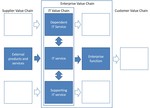Charting the IT chains of value
In this latest post on a service-oriented operating model for IT I will cover mapping out the IT value chain. There are quite a few steps which lead up to this point so start here if you want a reminder and don’t forget these warnings. So let’s get started with: what are IT value chains all about, why you need to take the time to map them and how do you use them.


